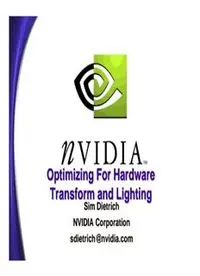
Optimizing For Hardware Transform and Lighting Optimizing For PDF
Preview Optimizing For Hardware Transform and Lighting Optimizing For
Optimizing For Hardware Transform and Lighting Sim Dietrich NVIDIA Corporation HW T&L : The Good News • Hardware T&L is extremely fast • GeForce2 GTS can achieve 22 million drawn triangles per second – Quadro2, Ultra even more • Using Hardware T&L correctly is very easy • In DX7, it all happens through VertexBuffers HW T&L : The Bad News • Using HW T&L incorrectly is even *easier* than getting it right • Some apps are slower when first ported to T&L! • Why? Because the obvious way to use VBs is NOT the right way • If you replace many DrawPrimitive calls with many DrawPrimitiveVB calls, you will be very disappointed HW T&L : A New API Path • The “D3D TnL HAL” Device is new for DX7 • It allows access to : • AGP and video memory vertex buffers • HW Texture Matrix • HW Texture Coordinate Generation “TexGen” • HW Fog • HW Lighting • HW Clipping • HW Transform & Projection The D3D TnL HAL • The TnL HAL is a different API and driver path than the HAL • It has different Performance Characteristics • Even more oriented towards batching than the HAL • Higher memory overhead for VBs • They are DDraw Surfaces, so have a 2K memory overhead • Very expensive to create VBs • Has the potential to be lighter-weight and faster than the HAL What is a Vertex Buffer, Anyway? • There are two answers to this question, one for Static VBs, and one for Dynamic VBs • Static VBs are like textures. You create them at level load time in AGP or video memory and leave them there • Great for terrain, rigid-body objects • Not good for skinned, animated characters or procedural effects • NEVER create a VB at runtime – it can take 100s of milliseconds Vertex Buffers are Write Only • They are not designed for getting results back with ProcessVertices() • You can never get the result of T&L back • But that’s OK • If you need to do collision detection or culling, you’d do best to use a separate simpler database anyway • Case in point – Do you really need to walk through U,Vs & diffuse colors when doing collision work? • VBs should always be WRITE_ONLY – even on non T&L devices Dynamic VBs • Dynamic VBs are sort of like like streaming DVD video • There is not enough space to hold every possible frame of animation, just like there wouldn’t be enough space to hold a DVD video in ram • Plus, many effects are truly dynamic and have an essentially infinite number of possible states • The focus is on getting the vertex data from the app to the card as efficiently as possible The Myths Of Dynamic VBs • If your data isn’t static, you can’t use T&L • Wrong, VBs were designed to handle Dynamic data, too • Dynamic T&L is so slow as to be worthless • Totally incorrect, Dynamic T&L is still faster than static CPU T&L • It is hard to manage Dynamic VBs • I have a single page of source code to prove this one wrong… Shared Resources • The GPU is a co-processor to the CPU • If you can keep both processors busy, speed will be excellent • However, to work together, the CPU and GPU must sometimes share resources • Textures • Frame Buffers • Vertex Buffers • If the sharing is managed poorly, you will get no overlap between the GPU and CPU and performance will suffer
